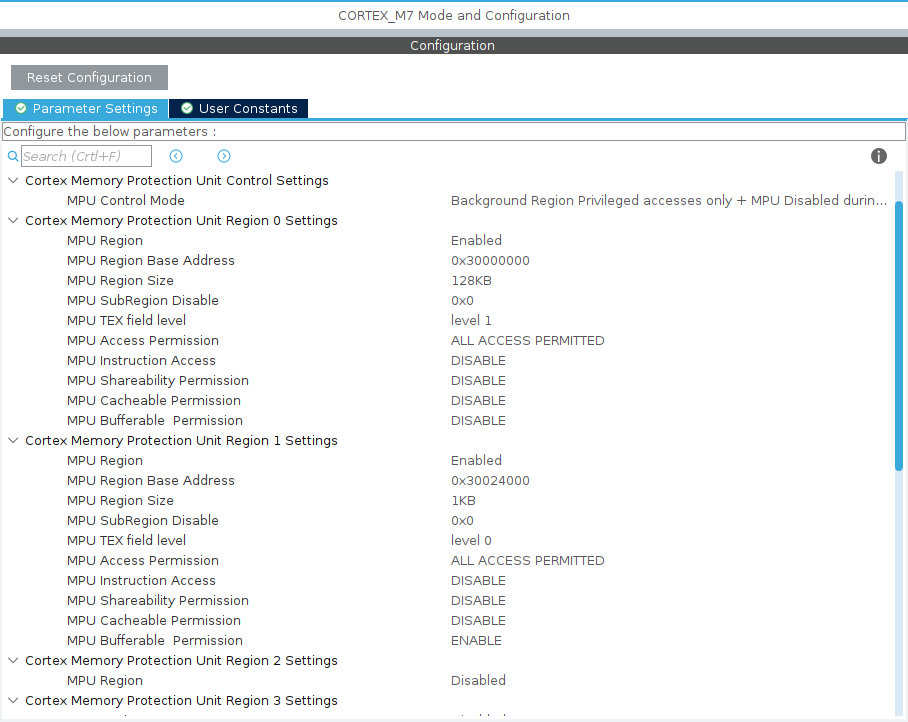This repository contains a functional Ethernet driver for the NUCLEO H743ZI2 development board from ST. It is based on V2 of the improved driver provided by Alister Fisher on the ST Community Forums with modifications to support the LAN8742A PHY found on the NUCLEO H743ZI2 boards.
This driver is needed because the ethernet driver provided by ST in STM32CubeIDE/STM32CubeMX is extremely buggy and unstable.
- Copy the modified
stm32h7xx_hal_eth.hfile into the same path asstm32h7xx_hal_conf.h(Core/Inc/by default). This should be enough to prevent the original version from being used. - Copy the modified
stm32h7xx_hal_eth.candethernetif.cfiles somewhere into your source tree. - Exclude the previous versions of these files (i.e.
Drivers/STM32H7xx_HAL_Driver/Src/stm32h7xx_hal_eth.candLWIP/Target/ethernetif.cfrom your build. - The original versions of
stm32h7xx_hal_eth.h,stm32h7xx_hal_eth.candethernetif.ccan then be safely deleted from your source tree (not mandatory, but may prevent confusion in the future).
I located all of the necessary memory in RAM_D2 as follows:
- 0x30000000: 128KB region (uncached) for Ethernet RX buffers
- 0x30020000: 16KB region (cached) for Ethernet TX buffers
- 0x30024000: 1KB region (uncached, strongly ordered) for Ethernet descriptors
The remainder of these instructions assume that this memory map is being used. If a different memory map is used, then pay particular attention to the following:
EthRxBlockshould be aligned on a 128K boundaryEthDescriptorsBlockshould be aligned on a 1K boundary
Assuming that the memory map is as I described above, then add the following to STM32H743ZITX_FLASH.ld:
.EthRxBlock (NOLOAD) :
{
/* MPU region for the ETH rx buffers: 128KB at start of D2 region.
* Rationale: To conserve memory we want the rx buffers to be uncached.
* If they were cached, the starts and ends of each rx buffer must be
* cache-line aligned to avoid corrupting the pbuf part when the
* buffer's invalidated following DMA receive. */
. = ABSOLUTE(0x30000000);
*(.RxArraySection)
} >RAM_D2 AT> FLASH
.EthTxBlock (NOLOAD) :
{
/* Normal, cached memory for the LwIP heap: 16KB following EthRxBlock.
* Rationale: LwIP allocates ETH tx buffers on its heap, and so to position
* the tx buffers in the D2 domain we must relocate the entire heap. */
. = ABSOLUTE(0x30020000);
*(.TxArraySection)
} >RAM_D2 AT> FLASH
.EthDescriptorsBlock (NOLOAD) :
{
/* MPU region for the ETH rx and tx descriptors: 1KB following EthTxBlock.
* Rationale: to guarantee memory accesses complete in program order so
* memory barriers aren't necessary. */
. = ABSOLUTE(0x30024000);
*(.RxDecripSection)
*(.TxDecripSection)
. = ALIGN(1K);
} >RAM_D2 AT> FLASH
- Navigate to Connectivity -> ETH -> Parameter Settings
- Set Rx Buffers Length to 1024. This will set
ETH_RX_BUFFER_SIZEto 1024 in inlwipopts.h. - The other values (Tx Descriptor Length, First Tx Descriptor Address, Rx Descriptor Length, First Rx Descriptor Address, Rx Buffers Address) are not used and can safely be set to 0
- Make sure that Ethernet global interrupt is enabled in NVIC Settings
- Navigate to Middleware -> LWIP -> Key Options
- Enable Show Advanced Parameters
- Infrastructure - Core Locking and MPU Option -> LWIP_MPU_COMPATIBLE (Special Memory Management) -> Set to Enabled. This will set
LWIP_MPU_COMPATIBLEto 1 inlwipopts.h. - Infrastructure - Heap and Memory Pools Options -> MEM_SIZE (Heap Memory Size) -> Set to 16000 Byte(s). This will set
MEM_SIZEto 16000 inlwipopts.h. - Infrastructure - Heap and Memory Pools Options -> LWIP_RAM_HEAP_POINTER (RAM Heap Pointer) -> Set to 0x30020000. This will set
LWIP_RAM_HEAP_POINTERto 0x30020000 inlwipopts.h.
- Nativate to System Core -> CORETEX_M7 -> Parameter Settings
- Configure settings as shown below:
The resulting code should be as follows:
void MPU_Config(void)
{
MPU_Region_InitTypeDef MPU_InitStruct = {0};
/* Disables the MPU */
HAL_MPU_Disable();
/** Initializes and configures the Region and the memory to be protected
*/
MPU_InitStruct.Enable = MPU_REGION_ENABLE;
MPU_InitStruct.Number = MPU_REGION_NUMBER0;
MPU_InitStruct.BaseAddress = 0x30000000;
MPU_InitStruct.Size = MPU_REGION_SIZE_128KB;
MPU_InitStruct.SubRegionDisable = 0x0;
MPU_InitStruct.TypeExtField = MPU_TEX_LEVEL1;
MPU_InitStruct.AccessPermission = MPU_REGION_FULL_ACCESS;
MPU_InitStruct.DisableExec = MPU_INSTRUCTION_ACCESS_DISABLE;
MPU_InitStruct.IsShareable = MPU_ACCESS_NOT_SHAREABLE;
MPU_InitStruct.IsCacheable = MPU_ACCESS_NOT_CACHEABLE;
MPU_InitStruct.IsBufferable = MPU_ACCESS_NOT_BUFFERABLE;
HAL_MPU_ConfigRegion(&MPU_InitStruct);
/** Initializes and configures the Region and the memory to be protected
*/
MPU_InitStruct.Enable = MPU_REGION_ENABLE;
MPU_InitStruct.Number = MPU_REGION_NUMBER1;
MPU_InitStruct.BaseAddress = 0x30024000;
MPU_InitStruct.Size = MPU_REGION_SIZE_1KB;
MPU_InitStruct.SubRegionDisable = 0x0;
MPU_InitStruct.TypeExtField = MPU_TEX_LEVEL0;
MPU_InitStruct.AccessPermission = MPU_REGION_FULL_ACCESS;
MPU_InitStruct.DisableExec = MPU_INSTRUCTION_ACCESS_DISABLE;
MPU_InitStruct.IsShareable = MPU_ACCESS_NOT_SHAREABLE;
MPU_InitStruct.IsCacheable = MPU_ACCESS_NOT_CACHEABLE;
MPU_InitStruct.IsBufferable = MPU_ACCESS_BUFFERABLE;
HAL_MPU_ConfigRegion(&MPU_InitStruct);
/* Enables the MPU */
HAL_MPU_Enable(MPU_PRIVILEGED_DEFAULT);
}
Project -> Generate Code
Add the following to the USER CODE 1 section in lwipopts.h:
#define LWIP_DEBUG 0
Project -> Build All
Thumbs up to Alister Fisher for his great work on improving the original driver from ST.
Thumbs down to ST for providing such a broken driver in the first place.
